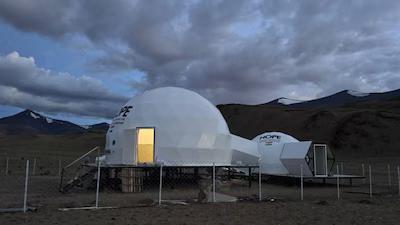
ISRO Sets Up Station in Ladakh to Simulate Life on Moon & Mars
In a move that marks a significant step towards its ambitious plans for lunar and Martian exploration, the Indian Space Research Organisation (ISRO) has set up the Himalayan Outpost for Planetary Exploration (HOPE) in Ladakh’s Tso Kar Valley. This innovative facility will serve as a simulation station to test life-support systems for upcoming missions to the Moon and Mars.
The HOPE station is designed to mimic the harsh conditions of the Martian environment, which is a crucial step in preparing for future human missions to the Red Planet. The Tso Kar Valley, with its high UV radiation, low atmospheric pressure, and extreme cold, offers an ideal location for this simulation. Additionally, the saline permafrost present in the valley is similar to the Martian surface, making it an ideal analogue for testing equipment and systems.
The simulation mission, which will run from August 1-10, will involve two crew members undertaking various tests at the facility. The team will be tasked with evaluating the effectiveness of the life-support systems, which will be crucial in sustaining human life during long-duration space missions.
The HOPE station is a significant development in ISRO’s plans for lunar and Martian exploration, which have gained momentum in recent years. The space agency has already made significant strides in its robotic missions to the Moon and Mars, including the successful Chandrayaan-1 mission, which orbited the Moon, and the Mars Orbiter Mission (MOM), which entered Martian orbit in 2014.
The HOPE station is an important step towards ISRO’s goal of sending humans to the Moon and Mars in the coming decades. The simulation mission will provide valuable insights into the challenges of living and working in extreme environments, and will help the space agency to develop and refine its life-support systems.
“The HOPE station is a unique facility that will enable us to test and validate the life-support systems for our upcoming lunar and Martian missions,” said an ISRO official. “The simulation mission will provide valuable data and insights that will help us to improve our systems and ensure the success of our future missions.”
The HOPE station is equipped with state-of-the-art facilities, including a life-support module, a communication module, and a habitat module. The station is designed to simulate the conditions of the Martian environment, including the low atmospheric pressure, extreme cold, and high UV radiation.
The simulation mission will involve a range of tests, including the evaluation of the life-support systems, communication systems, and habitat module. The crew members will also conduct experiments to simulate the effects of space travel on the human body, including the effects of microgravity and radiation.
The HOPE station is a collaborative effort between ISRO and various Indian research institutions, including the Indian Institute of Science (IISc) and the Indian Institute of Technology (IIT). The facility is designed to be modular and can be easily scaled up or down depending on the requirements of the mission.
In conclusion, the HOPE station is a significant development in ISRO’s plans for lunar and Martian exploration. The simulation mission will provide valuable insights into the challenges of living and working in extreme environments, and will help the space agency to develop and refine its life-support systems. As India’s space program continues to evolve and expand, the HOPE station will play an important role in paving the way for future human missions to the Moon and Mars.
Source:






